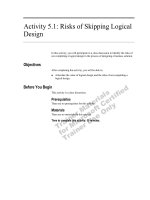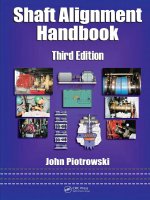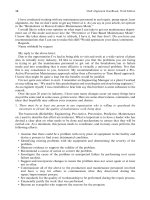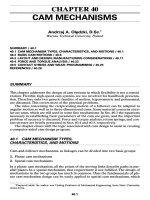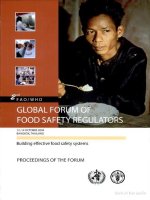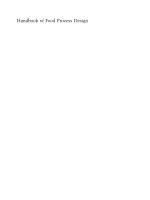Handbook of Food Process Design docx
Bạn đang xem bản rút gọn của tài liệu. Xem và tải ngay bản đầy đủ của tài liệu tại đây (14.82 MB, 1,533 trang )
Handbook of Food Process Design
Handbook of Food Process Design
Edited by
Jasim Ahmed, PhD
Kuwait Institute for Scientifi c Research
Safat, Kuwait
Mohammad Shafi ur Rahman, PhD
Sultan Qaboos University
Muscat, Sultanate of Oman
A John Wiley & Sons, Ltd., Publication
This edition fi rst published 2012 © 2012 by Blackwell Publishing Ltd.
Blackwell Publishing was acquired by John Wiley & Sons in February 2007. Blackwell’s publishing
program has been merged with Wiley’s global Scientifi c, Technical and Medical business to form
Wiley-Blackwell.
Registered offi ce: John Wiley & Sons, Ltd, The Atrium, Southern Gate, Chichester, West Sussex,
PO19 8SQ, UK
Editorial offi ces: 9600 Garsington Road, Oxford, OX4 2DQ, UK
The Atrium, Southern Gate, Chichester, West Sussex, PO19 8SQ, UK
2121 State Avenue, Ames, Iowa 50014-8300, USA
111 River Street, Hoboken, NJ 07030-5774, USA
For details of our global editorial offi ces, for customer services and for information about how to
apply for permission to reuse the copyright material in this book please see our website at
www.wiley.com/wiley-blackwell.
The right of the authors to be identifi ed as the authors of this work has been asserted in accordance with
the UK Copyright, Designs and Patents Act 1988.
All rights reserved. No part of this publication may be reproduced, stored in a retrieval system, or
transmitted, in any form or by any means, electronic, mechanical, photocopying, recording or otherwise,
except as permitted by the UK Copyright, Designs and Patents Act 1988, without the prior permission of
the publisher.
Designations used by companies to distinguish their products are often claimed as trademarks. All brand
names and product names used in this book are trade names, service marks, trademarks or registered
trademarks of their respective owners. The publisher is not associated with any product or vendor
mentioned in this book. This publication is designed to provide accurate and authoritative information
in regard to the subject matter covered. It is sold on the understanding that the publisher is not engaged
in rendering professional services. If professional advice or other expert assistance is required, the
services of a competent professional should be sought.
Library of Congress Cataloging-in-Publication Data
Handbook of food process design / edited by Jasim Ahmed, M.Shafiur Rahman.
p. cm.
Includes bibliographical references and index.
ISBN-13: 978-1-4443-3011-3 (hardback)
ISBN-10: 1-4443-3011-X (hardback)
1. Food processing plants–Design and construction. 2. Food processing machinery.
3. Food industry and trade. I. Rahman, Shafiur.
TH4526.H36 2011
664'.02–dc23
2011022689
A catalogue record for this book is available from the British Library.
Wiley also publishes its books in a variety of electronic formats. Some content that appears in print may
not be available in electronic books.
Set in 8/10 pt Trump Mediaeval by Toppan Best-set Premedia Limited
1 2012
All reasonable attempts have been made to contact the owners of copyrighted material used in this
book. However, if you are the copyright owner of any source used in this book which is not credited,
please notify the Publisher and this will be corrected in any subsequent reprints or new editions.
Preface xix
Acknowledgements xxi
About the Editors xxii
Contributors xxiv
1 Food Preservation and Processing Methods 1
Mohammad Shafi ur Rahman
Introduction 1
Purpose of Food Preservation 2
Food Preservation Methods 3
References 16
2 Food Process Design: Overview 18
Mohammad Shafi ur Rahman and Jasim Ahmed
Introduction 18
Components of Food Process Design 19
Unit Operations and Complete Process 20
Process Flow Diagram 20
Codes, Standards and Recommended Practices 21
Process Severity, Quality and Safety 22
References 23
3 Units and Dimensions 24
E. Özgül Evranuz
Introduction 24
Systems of Measurement 25
Contents
vi Contents
The SI System 27
Defi nition of Some Derived Physical Quantities 28
Dimensional Consistency 35
Precision and Accuracy 35
Unit Conversions 36
Guidelines for Using SI Units 36
References 38
4 Material and Energy Balances 39
E. Özgül Evranuz and Meral Kılıç-Akyılmaz
Introduction 39
Fundamentals of Material Balances 40
Examples of Material Balance Calculations with and without
Reaction 45
Overview of Food Processes 53
Energy Balances 56
Examples of Material and Energy Balances in Food Processing 65
References 71
5 Thermodynamics in Food Process Design 74
Santanu Basu and Pinaki Bhattacharya
Introduction 74
Thermodynamic Fundamentals 75
First Law of Thermodynamics: Conservation of Energy 76
Second Law of Thermodynamics: Entropy 82
Application of Thermodynamics in Food Systems 89
References 111
6 Chemical Reaction Kinetics Pertaining to Foods 113
Jasim Ahmed, Kirk Dolan and Dharmendra Mishra
Introduction 113
Basics of Chemical Reaction Kinetics 114
Types of Reactions 115
Fraction Conversion Concept 118
Temperature Dependence of the Rate Constants 119
Types of Reactor 120
Reaction Kinetics Related to Food 122
Statistical Aspects of Kinetic Modeling 144
Conclusions 158
References 159
Contents vii
7 Thermal Food Processing Optimization: Single and Multi-objective
Optimization Case Studies 167
Ricardo Simpson and Alik Abakarov
Introduction 167
Types of Optimization Methods 169
Single-objective Optimization of Thermal Food Processing 171
Multi-objective Optimization of Thermal Food Processing 173
Results and Discussion 177
Summary and Conclusion 185
References 185
8 Instrumentation, Sensor Design and Selection 190
Weibiao Zhou and Nantawan Therdthai
Introduction 190
Classifi cation of Sensors 191
Measurements and Sensors in Food Process Control Systems 192
Criteria for Selection of Sensors 197
Recently Developed Measurement Techniques for Food Processes 201
Summary 207
References 207
9 Automation and Process Control 211
Kazi Bayzid Kabir and M.A.A. Shoukat Choudhury
Introduction 211
Food Processing Automation and Control: Current Status 212
Basic Control Theory 217
Current Practice and Future Trends in Food Process Automation 233
Conclusions 236
References 236
10 Use of Various Computational Tools and gPROMS for Modelling
Simulation Optimisation and Control of Food Processes 239
I.M. Mujtaba
Introduction 239
Reactor in Food Processing 240
Distillation in Food Processing 242
Extraction in Food Processing 244
Thermal Treatments in Food Processing 245
Model-based Techniques in Food Processing: Simulation, Optimisation
and Control 246
Food Properties in Model-based Techniques 250
Computational Software in Food Processing 251
viii Contents
Conclusions 253
References 254
11 Fluid Flow and Pump Selection 262
Jasim Ahmed and Rajib Ul Alam Uzzal
Introduction 262
Nature of Fluids 262
Basic Equations Related to Fluid Flow 269
Measurement of Flowing Fluids 278
Pipes, Fittings and Valves 282
Pumps 290
Fans, Blowers and Compressors 294
Selection of Pump and Performance Evaluation 295
References 296
12 Heating and Cooling System Analysis Based on Complete
Process Network 299
Martín Picón-Núñez
Introduction 299
Determination of Process Heating and Cooling Needs 300
Process Heating 310
Process Cooling 315
Heat Exchangers for Heating and Cooling in the Food Industry 329
Summary 332
References 333
13 Pasteurisation Process Design 335
Gary Tucker
Introduction 335
HACCP in Pasteurisation Process Design 336
Processing Options 337
Pasteurisation Design Principles 339
Empirical Data and P-Value Guidelines 341
Equipment for Pasteurisation Processes 343
Summary and Future Trends 360
References 361
Further Reading 361
14 Sterilization Process Design 362
Ricardo Simpson, Helena Núñez and Sergio Almonacid
Introduction 362
Importance of Microorganisms in Sterilization and Pasteurization 363
Heat Transfer in Thermal Processing 370
Contents ix
Quality Evaluation 373
Industrial Equipment 375
Acknowledgments 379
References 379
15 Refrigeration, Air Conditioning and Cold Storage 381
Mohd. Kaleem Khan
Introduction 381
Refrigeration 382
Air Conditioning Systems 399
Cold Storage 410
Worked Examples 413
References 428
16 Chilling, Freezing and Thawing Process Design 430
Mohammad Shafi ur Rahman
Introduction 430
Chilling 430
Freezing 433
Thawing 452
Nomenclature 453
References 455
17 Thermal Evaporator Design 460
Tarif Ali Adib
Introduction 460
Thermophysical Properties of Liquid Food 461
Characteristics of Liquids and Some Evaporator Problems 462
Single-effect Evaporator and Design Calculations for Evaporators 463
Types of Evaporator 465
Heat Transfer Coeffi cient in Evaporators 470
Energy Economics 475
Hygienic Design and Methods of Cleaning 479
Example 481
Nomenclature 485
References 487
18 Food Processing and Control by Air Jet Impingement 489
Gianpaolo Ruocco and Maria Valeria De Bonis
Introduction 489
Principles of Air Jet Impingement 491
A Conjugate Approach 493
x Contents
Food Processing and Control of Heating/Drying Treatments 499
Conclusions 505
Nomenclature 506
References 508
19 Hot Air Drying Design: Tray and Tunnel Dryer 510
Jasim Ahmed, U.S. Shivhare and Rajib Ul Alam Uzzal
Introduction 510
Drying of Food 513
Drying Systems 518
Design Considerations in Tray and Tunnel Dryers 519
Design of Tray Dryers 520
Design of Tunnel Dryers 528
Economic Performance of Tray and Tunnel Dryers 536
Energy Management of Tray and Tunnel Dryers 538
Costs of Drying Operations 538
Conclusions 539
Acknowledgment 539
References 539
20 Hot Air Drying Design: Fluidized Bed Drying 542
R.T. Patil and Dattatreya M. Kadam
Introduction 542
Design Features 544
Design of HTST Pneumatic Fluidized Bed Dryer 559
Types of Fluidized Bed Dryers 564
Application of Fluidized Bed Drying 572
Acknowledgment 576
Further Reading 576
Websites 577
21 Heat Pump Design for Food Processing 578
M.N.A. Hawlader and K.A. Jahangeer
Introduction 578
Types of Heat Pump 580
Drying of Agricultural Products and Heat Pump 582
Heat Pumps for Food Processing 584
Modelling, Simulation and Design of Heat Pumps 594
Practice Problems 612
Summary 615
Nomenclature 616
References 618
Contents xi
22 Freeze-drying Process Design 621
Cristina Ratti
Introduction 621
Underlying Principles of Freeze-drying 622
Process Design 625
Modeling the Process 636
Industrial Freeze-drying 636
Costs 639
Unconventional Freeze-drying 640
Conclusions 641
References 642
23 Crystallization Process Design 648
John J. Fitzpatrick
Introduction 648
Crystallization 651
Crystallization Equipment 660
Process Design of Batch Cooling Crystallizers 663
Process Design of Continuous Evaporative and Vacuum Evaporative
Crystallizers 672
Monitoring and Control of Crystallization Processes 678
References 680
24 Aseptic Process Design 682
Prabhat Kumar, K.P. Sandeep and Josip Simunovic
Introduction 682
History of Aseptic Processing 683
Important Aspects of Aseptic Process Design 686
Regulations Related to Aseptic Processing 705
Case Study: Aseptic Processing of Sweetpotato Purée 705
Future Trends 707
References 707
25 Extrusion Process Design 710
Kasiviswanathan Muthukumarappan and Chinnadurai Karunanithy
Introduction 710
Types of Extruder 711
Extruder Components 712
Extruder Variables 720
Feed Ingredient Variables 720
Interactions Between Extruder and Ingredient Variables 722
Product Qualities 727
xii Contents
Supercritical Fluid Extrusion 732
Cost Economics of Extrusion 734
Conclusions 734
References 735
26 Baking Process Design 743
Emmanuel Purlis
Introduction 743
The Baking Process 745
Baking Design Based on Process Modelling and Simulation 751
Baking Equipment 756
Trends in Baking Technology 759
Conclusions 760
Appendix: Worked Examples 761
Nomenclature 765
References 766
27 Membrane Separation and Design 769
Rohit Ruhal and Bijan Choudhury
Introduction 769
Process Flow-sheet for Membrane Operation 770
Basic Theoretical Principle, Membrane Operation Mode
and Membrane Materials 772
Membrane Modules 773
Types of Membrane Process 775
Flux Equations 779
Mode of Operation 781
Design of Membrane 782
Fouling of Membrane in Ultrafi ltration and Microfi ltration 784
Cleaning and Sanitation 784
Cost 784
Applications 784
Conclusions 786
References 787
28 Food Frying Process Design 789
Ferruh Erdogdu and T. Koray Palazoglu
Introduction 789
Fried Products 793
Contents xiii
Quality Attributes of Fried Products 793
Frying Oils 795
Frying Equipment 797
Heat and Mass Transfer during Frying 801
Process Control 805
Conclusions and Future Needs 806
References 807
29 Mechanical Separation Design 811
Timothy J. Bowser
Defi nition and Purpose 811
Food Products Processed by Mechanical Separation 812
Theoretical Principles of Mechanical Separation 812
Equipment Used for Mechanical Separation 816
Design of Mechanical Separation Processes 824
Process Control 827
Hazard and Safety Issues 828
Cleaning and Sanitation Methods 828
Capital and Operating Costs 829
Future Needs 829
References 830
30 Mixing and Agitation Design 834
Siddhartha Singha and Tapobrata Panda
Introduction 834
Mixing and Agitation: Theoretical Principles 835
Mixing Equipment: Mode of Operation and Comparative Analysis 839
Design Principles of Mixers in the Food Industry 849
Operational Issues of Mixing Equipment 863
Capital and Operating Costs for Different-sized Equipment 866
Summary and Future Needs 867
References 868
31 Extraction Process Design 871
Q. Tuan Pham and Frank P. Lucien
Introduction 871
Liquid–Liquid Extraction 872
Solid–Liquid Extraction (Leaching) 890
Supercritical Fluid Extraction 901
Hygienic Design Aspects 909
Economics 911
Summary and Future Needs 912
xiv Contents
Nomenclature 913
References 915
32 Size Reduction Process Design 919
M. Reza Zareifard, Ali Esehaghbeygi and Amin Allah Masoumi
Introduction 919
Texture of Materials 921
Size Classifi cations 921
Size Reduction Procedures 925
Types of Stresses and Energy Requirements 928
Performance Characteristics 934
Devices 936
Solid Foods Size Reduction 949
Liquid Foods Size Reduction 951
Nanoparticles in the Food Industry 955
References 961
33 Irradiation Process Design 967
Rod Chu
Introduction 967
Applications of Food Irradiation 969
The Food Irradiation Process 970
The Food Irradiation Process Flow 971
Basic Theoretical Principles 972
Design Considerations for Food Irradiators 975
Rules of Thumb 980
Simple Equations 982
Process Control 985
Software for Modeling Food Irradiators 987
Cleaning and Sanitation Methods 990
Capital and Operating Costs for Different Sizes of Equipment 991
Summary and Future Needs 992
Examples of Food Irradiators 993
References 994
34 Design for High-Pressure Processing 998
Tatiana Koutchma
Introduction 998
The Commercial Market for HHP-Processed Products 999
The Potential of HHP Technology as a Unit Operation 999
The HHP Processing Cycle 1002
Contents xv
HHP Pasteurization 1004
HHP Sterilization 1005
Mode of Operation 1005
The Design of High-Pressure Vessels 1008
Commercial HHP Vessels and Process Economics 1010
The Regulatory Status of HHP Processing 1011
Basic Theoretical Principles 1012
Design and Calculations for HHP Preservation Processes 1017
Summary and Future Needs 1024
References 1025
35 Microwave and Radio-Frequency Heating Processes for Food 1031
Francesco Marra
Introduction 1031
Indirect Electroheating: Basic Information about MW and RF Heating 1032
Empirical Data and Properties Needed for Designing MW
and RF Processes 1038
Conceptual Design of Electroheating Processes 1040
Equipment 1041
Processes, Products and Potential Products 1044
MW and RF Safety Guidelines 1049
The Economics of MW and RF Processing 1050
References 1052
36 Design of Ohmic Heating Processes 1057
Ilkay Sensoy
Introduction 1057
Applications of Ohmic Heating and Moderate-Electric-Field Processing 1059
The Ohmic Heating Process 1062
Summary and Future Needs 1071
Nomenclature 1071
References 1072
37 Design of Equipment for Pulsed Electric Field Processing 1078
Federico Gómez Galindo and Pär Henriksson
Introduction 1078
Principles and Technology 1080
Calculations, Monitoring and Optimization of Treatment Parameters 1093
Capital and Operating Costs 1097
Summary and Future Needs 1098
References 1100
xvi Contents
38 Process Design Involving Ultrasound 1107
Jordi Salazar, Antoni Turó, Juan A. Chávez
and Miguel J. García-Hernández
Introduction 1107
Fundamentals of Ultrasound 1108
Low-Intensity Ultrasound 1109
High-Intensity Ultrasound 1134
Conclusions 1155
References 1156
39 Process Design Involving Pulsed UV Light 1166
Ali Demirci and Nene M. Keklik
Introduction 1166
End Products of the Process 1167
Process Components 1170
Basic Theoretical Principles and Mode of Operation 1171
Equipment (Advantages and Limitations) and Parameters 1173
Empirical Data and Rules of Thumb 1174
Estimation of the Design Parameters 1177
Process Control, Operations and Maintenance 1178
Advanced Levels of Process Design for Complicated Systems 1178
Cleaning and Sanitation Techniques 1179
Capital and Operating Costs 1180
Examples of Studies 1180
Worked Examples 1182
Summary and Future Needs 1183
References 1184
40 High-Voltage Food Processing Technology: Theory, Processing
Design and Applications 1188
Paul Takhistov
Introduction 1188
Unifi ed Analysis of Electric-Field-Based Food
Processing Technologies 1190
Pulsed Electric Fields in Food Processing and Preservation 1202
Treatment Chambers and Equipment 1203
Mechanisms of Microbial Inactivation 1207
Events in Electroporation and Microbial Lysis 1208
Kinetics of Microbial Inactivation 1211
PEF Process Calculations and Variables 1213
Mathematical Model of Continuous Operation (Esplugas et al., 2001) 1218
Contents xvii
Process Calculations 1219
Physical Properties of Food Products for PEF Processing 1219
Application of PEF Treatment to Food Preservation 1221
PEF Treatment as a Hurdle Technology 1225
References 1229
41 An Overview of Food Packaging: Material Selection and
the Future of Packaging 1237
Jasim Ahmed and Tanweer Alam
Introduction 1237
Why Do We Need Packaging? 1239
Mass Transfer and Food–Package Interactions 1242
Food Packaging Materials 1245
Sterilization of Packaging Materials 1256
Packaging Design 1258
Packaging for Nonthermal Processes 1260
Biodegradable Packaging 1266
The Future of Packaging 1268
Packaging Safety, Legislation and Regulations 1274
Conclusions 1276
References 1276
42 Mass Transport Phenomena in Food Packaging Design 1284
Marcella Mastromatteo, Amalia Conte and Matteo Alessandro
Del Nobile
Introduction 1284
Barrier Properties: Steady State 1288
Barrier Properties: Transient State 1320
References 1332
43 Design of Modifi ed and Controlled Atmospheres 1340
Gurbuz Gunes and Celale Kirkin
Introduction 1340
Gases Used in Modifi ed Atmospheres 1341
Packaging Materials 1342
Design of Modifi ed-Atmosphere Packaging for Foods 1343
Equipment for MAP 1359
Controlled-Atmosphere Storage 1360
Nomenclature 1361
References 1362
xviii Contents
44 Packaging for Processed Food and the Environment 1369
Eva Almenar, Muhammad Siddiq and Crispin Merkel
Introduction 1369
Packaging for Processed Food and the Environment 1370
Traditional Packaging Materials and the Environment 1379
Novel Packaging Materials and the Environment 1390
The Future: the Role of Consumers and the Food Industry in the
Impact of Packaging on the Environment 1395
Acknowledgment 1397
References 1398
45 Food Quality and Safety Assurance by Hazard Analysis and
Critical Control Point 1406
Tomás Norton and Brijesh Tiwari
Introduction 1406
Introduction to Hazard Analysis Critical Control Points (HACCP) 1408
The Advantages of Using the HACCP Approach 1410
Prerequisite Programmes 1411
Developing a HACCP Plan 1412
The Seven Principles of HACCP 1413
Implementing the HACCP Plan 1415
Using HACCP during Food Manufacturing 1420
HACCP in a Meat Plant 1422
HACCP in a Cheese Plant 1425
HACCP in a Fish-Smoking Plant 1425
The Infl uence of HACCP on Hygienic Design 1429
Combining HACCP and ISO 22000:2005 1431
References 1433
46 Commercial Imperatives 1436
Gerard La Rooy
Introduction 1436
Fundamental Financial Matters 1437
Financial Impacts of Technical Projects 1442
Analytical Concepts and Techniques 1444
Process Variability 1452
Adopting a ‘Process-Based Approach’ 1455
A Sound Design Process 1460
Applying the Concepts and Techniques 1470
References 1470
Generally, a process is defi ned as a sequence of events that transforms the biological
materials of food products, via biochemical changes, into stable forms with added
value. This can create new products or modify existing ones. Process design refers to
the design of food processes and manufacturing methods, while plant design refers to
the design of the whole processing plant. The processing of food is no longer as simple
or straightforward as in the past. Food process design is an interdisciplinary science
that is highly regarded by the food industry. The architecture of food process engineer-
ing is based on the solid foundations of chemical and mechanical engineering, together
with the basics of microbiology, chemistry, nutrition, and economics. Other related
disciplines, including instrumentation, computer science and mathematics, complete
the discipline. Process design is the core of food engineering, and frequently begins
with a concept and eventually ends in fabrication. Many types of documentation are
involved in the process to test theories, display results, and organize data.
Today, the food industry is one of the largest manufacturing industries in the world
and the signifi cant contribution of food engineers to the industry is well recognized.
A professional food engineer should be well versed in the basic principles, processes,
fl ow diagrams, instrumentation and process control. The Handbook of Food Process
Design has been developed primarily for fulfi lling these expectations and is intended
to be used by students in undergraduate and graduate courses in food process engineer-
ing/food technology/biochemical engineering, as well as by professionals working in
the food industry. It could also be used by graduates in other disciplines, such as
chemical and/or mechanical engineering.
The editors of this book have vast experience in teaching, research, and extension
activities related to the food industry and have long realized the need for such a hand-
book on process equipment design to fi ll the current gap in the basic and applied fi elds
of food engineering. They have endeavoured to gather eminent academics and profes-
sionals from across the globe and have succeeded in securing their participation in
this book. All the contributors have diverse backgrounds, ranging from electronic
engineering to food science.
The book contains 46 chapters in two volumes, with chapters grouped according to
their similar subject matter. Chapters 1 – 12 are devoted to the basic principles, starting
with units and dimensions, moving on to thermodynamics and reaction kinetics per-
taining to foods, and followed by sensors and instrumentation involved in process
automation. The handbook is well balanced by its coverage of unit operations involved
in conventional and novel processing technologies to be used by the food industry.
Preface
xx Preface
Each chapter is intended to provide concise up - to - date descriptions of fundamentals,
applications, solved problems, and methods of cost analysis. Chapters 13 – 18 cover
heating and cooling systems used in food processing, including pasteurization, steri-
lization, refrigeration, and freezing. Drying is considered one of the most successful
unit operations used in the food industry. Process design related to the drying of food
materials is covered in Chapters 19 – 22 .
Some important process designs, such as crystallization, extrusion, aseptic process-
ing, baking, and frying, are well discussed in Chapters 23 – 28 . Chapters 29 – 32 cover
mechanical operations related to food process industries, including mixing/agitation,
size reduction, and extraction and leaching processes. Chapters 33 – 40 focus on novel
process designs, including pulsed light, ultrasound, ohmic heating, pulsed electric
fi eld, high pressure, and irradiation. Food packaging is discussed in Chapters 41 – 44 ,
while quality systems and cost analysis are covered in Chapters 45 and 46 .
The editors are confi dent that this handbook will prove to be interesting, informa-
tive, and enlightening to readers in the fi eld. They would appreciate receiving new
information and comments to assist in future development of the next edition.
Jasim Ahmed
Mohammad Shafi ur Rahman
We would like to thank Almighty Allah for giving us life and the opportunity to gain
knowledge to write this important book. We wish to express our sincere gratitude to
the Sultan Qaboos University, Polymer Source Inc. and Kuwait Institute for Scientifi c
Research for providing the opportunity and facilities to execute such an exciting
project, and for supporting us in research and other intellectual activities around the
globe.
We sincerely acknowledge the sacrifi ces made by our parents during our early edu-
cation. Appreciation is due to all our teachers in the course of our careers. Special
thanks to our colleagues and other research team members for their support and
encouragement. We are grateful to our contributors for their wonderful cooperation
and, fi nally, we are indebted to our families for their continued support and patience
throughout the project.
Acknowledgements
Jasim Ahmed
Jasim Ahmed, Research Scientist, at Kuwait Institute for Scientifi c Research, Kuwait,
is the author or co - author of over 150 technical articles including 95 refereed journal
papers, 40 conference papers, 18 book chapters, 20 popular articles, and 4 books. He
has edited several books including Novel Food Processing: Effects on Rheological and
Functional Properties and Starch - based Polymeric Materials and Nanocomposites:
Starch Chemistry, Processing and Applications published by CRC Press, Boca Raton,
Florida, and Handbook of Vegetables and Vegetables Processing and Handbook of
Tropical and Subtropical Fruits Processing and Packaging published by Wiley -
Blackwell, NJ.
Dr Ahmed has served as an editor of the International Journal of Food Properties
for more than 5 years. Furthermore, he has served as special editor for a number of
other journals. He is also associated with the editorial boards of three international
journals. In 2010, he was invited to serve as a sub - panel member for the Food Processing
and Packaging Section of the Institute of Food Technology (IFT), Chicago, USA.
Dr Ahmed is a professional member of the Institute of Food Technology (IFT) and
a life member of the Association of Food Scientists and Technologists (AFST), India.
He has been involved in many professional activities, such as organizing international
conferences, industrial training and workshops. He received the BTech (Food and
Biochemical Engineering) in 1991 and MTech (Food and Biochemical Engineering) in
1993 from Jadavpur University, Kolkata, India, and PhD in Food Technology in 2000
from GND University, India. He worked as Visiting Professor and Research Director
at McGill University, and Polymer Source Inc., Montreal, Canada, before moving to
Kuwait.
Dr Ahmed was awarded a gold medal by Jadavpur University, India for securing the
top position in the M.Tech degree. He has received several grants from various funding
agencies to carry out his research during his academic career. He received a best
reviewers ’ award by Elsevier in the area of food engineering in 2009.
Dr Ahmed has been involved in food processing teaching, research and industry over
18 years and has proved himself an active scientist in the area of food engineering. He
has worked on food product development, food rheology and structure, novel food
processing and the thermal behaviors of foods. His current research focus is on
biopolymer and starch - based nanocomposites. Dr Ahmed ’ s work has been well recog-
nized globally: there are more than 1000 citations of his work and his h - index is 20.
About the Editors
About the Editors xxiii
Mohammad Shafi ur Rahman
Mohammad Shafi ur Rahman, Professor at the Sultan Qaboos University, Sultanate of
Oman, is the author or co - author of over 250 technical articles including 90 refereed
journal papers, 87 conference papers, 58 book chapters, 34 reports, 12 popular articles,
and seven books. He is the author of the internationally acclaimed and award - wining
Food Properties Handbook , published by CRC Press, Boca Raton, Florida, which was
one of CRC ’ s bestsellers in 2002. The second edition is now released under his editor-
ship. He was also the editor of the popular book Handbook of Food Preservation
published by CRC Press, Boca Raton, Florida. The fi rst edition was one of CRC ’ s
bestsellers in 2003, and the second edition is now on the market. He was invited to
serve as one of the associate editors for the Handbook of Food Science, Engineering
and Technology , and as one of the editors for the Handbook of Food and Bioprocess
Modeling Techniques published by CRC Press.
Professor Rahman initiated the International Journal of Food Properties (published
by Marcel Dekker) and has served as the founding editor for more than 10 years. He
also serves on the editorial boards of eight international journals. He is a member on
the Food Engineering Series Editorial Board of Springer Science, New York, and serves
as a section editor for the Sultan Qaboos University Journal of Agricultural Sciences.
In 1998 he was invited to serve as a Food Science Adviser for the International
Foundation for Science (IFS) in Sweden.
Professor Rahman is a professional member of the New Zealand Institute of Food
Science and Technology and the Institute of Food Technologists, a member of the
American Society of Agricultural Engineers and the American Institute of Chemical
Engineers, and Member of the Executive Committee of the International Society of
Food Engineering (ISFE). He has been involved in many professional activities, such
as organizing international conferences, training workshops and other extension activ-
ities related to the food industry. He has been a keynote/plenary speaker at many
international conferences. He received the BSc Eng. (Chemical) in 1983 and MSc Eng.
(Chemical) in 1984 from Bangladesh University of Engineering and Technology,
Dhaka, MSc in food engineering in 1985 from Leeds University, England, and PhD in
food engineering in 1992 from the University of New South Wales, Sydney, Australia.
Professor Rahman has received numerous awards and fellowships in recognition of
his research and teaching achievements, including the HortResearch Chairman ’ s
Award, the Bilateral Research Activities Program (BRAP) Award, CAMS Outstanding
Researcher Award 2003, SQU Distinction in Research Award 2008, and the British
Council Fellowship. In 2008 Professor Rahman ranked among the top fi ve leading
scientists and engineers of 57 OIC member states in the agroscience discipline.
Professor Rahman is an eminent scientist and academic in the area of food process-
ing. He is recognized for his signifi cant contributions to the basic and applied knowl-
edge of food properties related to food structure, engineering properties and food
stability. His total SCOPUS citation is more than 1200 and his h - index is 20, which
indicates the high impact of his research in the international scientifi c community.
Mohammad Shafi ur Rahman, PhD
Professor
Department of Food Science and Nutrition, Sultan Qaboos University, Muscat,
Oman
email: shafi
Jasim Ahmed, PhD
Research Scientist
Food and Nutrition Program, Kuwait Institute for Scientifi c Research, Safat, Kuwait
email: and
Alik Abakarov, PhD
Visiting Professor
Technical University of Madrid, Higher Technical School of Agricultural
Engineering, Madrid, Spain
email:
Tarif Ali Adib, PhD
Research Scientist
Water Quality Observation Laboratory, Lattakia, Syria
email:
Rajib Ul Alam Uzzal, PhD
Powertrain Control Engineer
Chrysler Technical Center
Chrysler Drive, Auburn Hills, Michigan, USA
email:
Tanweer Alam, PhD
Associate Professor (Joint Director)
Indian Institute of Packaging, Mumbai, India
email:
Contributors
Contributors xxv
Eva Almenar, PhD
Assistant Professor
School of Packaging, Michigan State University, East Lansing, Michigan, USA
email:
Sergio Almonacid, PhD
Associate Professor
Department of Chemical and Environmental Engineering, Universidad T é cnica
Federico Santa Mar í a, Valpara í so, Chile.
email:
Santanu Basu, PhD
Associate Professor
Department of Food Engineering
National Institute of Food Technology, Entrepreneurship and Management, Kundli,
Haryana, India
email:
Pinaki Bhattacharya, PhD
Professor
Department of Chemical Engineering, Jadavpur University, Kolkata, India
email:
Timothy J. Bowser, PhD, PE
Associate Professor
Department of Biosystems and Agricultural Engineering, and the Robert M.Kerr
Food and Agricultural Products Center
Oklahoma State University, Stillwater, Oklahoma, USA
email:
Juan A. Ch á vez, PhD
Associate Professor
Sensor Systems Group, Department of Electronic Engineering, Universitat
Polit è cnica de Catalunya, Barcelona, Spain
email:
Bijan Choudhury, PhD
Assistant Professor
Department of Biotechnology, Indian Institute of Technology, Roorkee, India
email:
xxvi Contributors
M.A.A. Shoukat Choudhury, PhD
Assistant Professor
Department of Chemical Engineering, Bangladesh University of Engineering and
Technology, Dhaka, Bangladesh
email:
Rod Chu, BS
Retired Scientist
Ottawa, Ontario, Canada
email:
Amalia Conte, PhD
Researcher
Department of Food Science, University of Foggia and Istituto per la Ricerca e le
Applicazioni Biotecnologiche per la Sicurezza e la Valorizzazione dei Prodotti Tipici
e di Qualit à – BIOAGROMED, Foggia, Italy
email:
Maria Valeria De Bonis, PhD
Post - doctoral teaching assistant
CFDfood - DITEC, Universit à degli Studi della Basilicata, Potenza, Italy
email:
Matteo Alessandro Del Nobile, PhD
Associate Professor
Department of Food Science, University of Foggia and Istituto per la Ricerca e le
Applicazioni Biotecnologiche per la Sicurezza e la Valorizzazione dei Prodotti Tipici
e di Qualit à – BIOAGROMED, Foggia, Italy
email:
Ali Demirci, PhD
Professor
Department of Agricultural and Biological Engineering, Pennsylvania State
University, University Park, Pennsylvania, USA
email:
Kirk Dolan, PhD
Associate Professor
Department of Food Science and Human Nutrition, Department of Biosystems and
Agricultural Engineering, Michigan State University, East Lansing, Michigan, USA
email:
